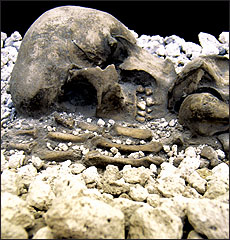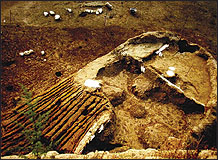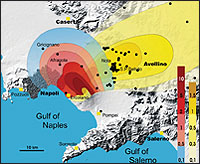Archives
Naples at risk in next Vesuvius eruption
New evidence on earlier eruption should be reference for hazard planning
By ELLEN GOLDBAUM
Contributing Editor
The UB Office of News Services, working with the PNAS, was able to secure significant international media coverage for this research, including features stories by The New York Times, USA Today, the Times of London, NPR's "Morning Edition," National Geographic, the Associated Press and Reuters news service.
Recently discovered geological and archaeological evidence is shedding light on a catastrophic eruption at Mt. Vesuvius during the Bronze Age that wrought broader destruction to surrounding areas than the famous Pompeii eruption of AD 79, according to a paper published in the Proceedings of the National Academy of Sciences.
The authors suggest that this event should be a reference for current hazard planning for metropolitan Naples, Italy, home to 3 million people.

The skeleton of a young woman
buried by one meter of pumice lapilli during the Bronze Age eruption of
Mt. Vesuvius was found in a self-protecting position typical of death
due to suffocation.
PHOTOS: COURTESY OF PNAS
The discovery reported in this paper is the first volcanological and archaeological evidence that Vesuvius ever produced an eruption that strongly affected the area now occupied by metropolitan Naples, said co-author Michael F. Sheridan, UB Distinguished Professor in the Department of Geology, College of Arts and Sciences and director of the department's Center for Geohazards.
"We didn't know that the city of Naples would be so threatened," said Sheridan, a volcanologist and risk-analysis expert. "We never had evidence for a blast extending into the Neopolitan area and beyond it."
An eruption of this magnitude would cause devastating upheaval in socio-economic terms, Sheridan said, since the densely populated metropolitan area now is the largest in southern Italy.

These footprints of two fugitives in the surge ash deposit of the eruption were found approximately 15 km north-northwest of Vesuvius.
He said that while there may not be a high probability that events like the Bronze-Age eruption or the eruption that buried Pompeii in AD 79 are going to occur in the near future, officials must still take those possibilities into account.
"There was this Bronze-Age eruption about 4,000 years ago, and then 2,000 years ago there was the AD 79 event. It seems that just about every 2,000 years, there's been a major eruption of this scale at Vesuvius," said Sheridan, who has studied all of the major eruptions at Vesuvius going back to the birth of the volcano 25,000 years ago.
"Using a standard statistical test, there is more than a 50 percent chance that a violent eruption will happen at Vesuvius next year," he said. "With each year that goes by, the statistical probability increases."
Discovery of the societal effects of the Bronze-Age eruption was made by a multidisciplinary team of archaeologists and volcanologists who co-authored the PNAS paper with Sheridan.
The co-authors are Giuseppe Mastrolorenzo, senior researcher, and Lucia Pappalardo, researcher, at Istituto Nazionale di Geofisica e Volcanologia-Osservatorio Vesuviano, and Pierpaolo Petrone, technical administrator at the Museo di Antropologia, Centro Musei delle Scienze Naturali.

A mold of one of a group of huts buried in the debris from Vesuvius. The hut roof partially collapsed, but its interior was filled by surge ash and perfectly preserved.
Based on archaeological findings, such as evidence of the abrupt abandonment of huts, as well as skeletons of people and livestock buried beneath more than one meter of pumice, the team members were able to reconstruct a chronology of what happened during the eruption.
Perhaps the most extraordinary finding was what the authors call "decisive proof of a massive exodus" from the area, demonstrated by the finding of thousands of human and animal footprints, embedded in the wet volcanic ash and leading away from the volcano.

This map shows areas actually covered by ash—red to orange and blue—and pumice—yellow—from the Bronze Age eruption. Approximately 80 percent of present day Naples (dark gray area north of the Gulf of Naples) would have been covered by a lethal thickness of ash.
The paper contends that most of the people who left probably survived because the early parts of the eruption consisted primarily of fallout of pumice, a light volcanic froth that forms during highly explosive eruptions and which often is not lethal in itself.
Nevertheless, the environmental damage, chiefly desertification, and the deposit of millions of cubic meters of ash and small pumice fragments likely occurred over thousands of square kilometers, making the area uninhabitable for decades at the very least and practically eliminating all socio-economic activities.
"This eruption is much larger than the ones that are currently anticipated at Vesuvius, like the eruption that occurred in 1631," said Sheridan. "However, such an event should be taken into account as a maximum probable-event scenario. Evacuation of 3 million people and their subsequent sporadic return could pose a real problem that must be carefully considered in the mitigation plans.
"The question is, 'Where do you put 3 million displaced people and for how long do they remain as evacuees?'" he asked.
Sheridan noted that as was the case after Hurricane Katrina, distribution of water, food and housing for the survivors and the nature of the escape routes also must be carefully considered with an evacuation of this magnitude.
"What must be taken into account are the temporary facilities where people could stay during the volcanic crisis to make sure that they are not located in zones that are too close to the volcano and where they could still be affected by the eruption," he said. "You certainly don't want to move people into the face of disaster."
Sheridan has spent four decades mapping hazards from active volcanoes in Italy, Mexico, Ecuador and around the world so that civil authorities know how and when to evacuate populations. He also serves on a U.S. Department of Energy expert panel to assess probabilistic volcanic hazards at Yucca Mountain, the planned ultimate repository for all of the United States' nuclear waste.
Last semester, Sheridan taught Geology 428/528, "Preventing Geologic Disasters," at UB. The course focused largely on Hurricane Katrina and assessed the lack of adequate mitigation planning and the tragic results as that disaster developed.
"There is a tendency to underestimate what geologists call the maximum probable event," said Sheridan. "It's politically negative to talk about the maximum probable hazard because you are purveying bad news and nobody in office wants to present this really bad news."
